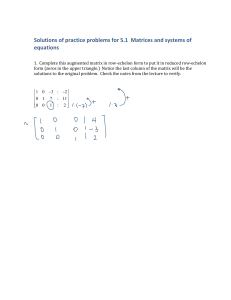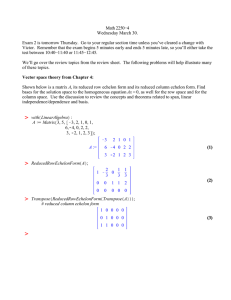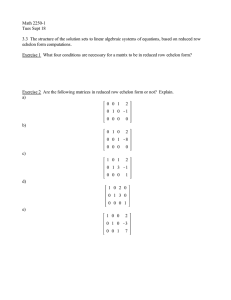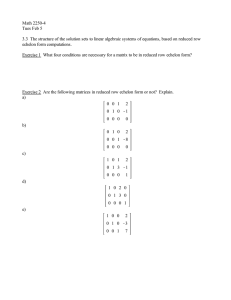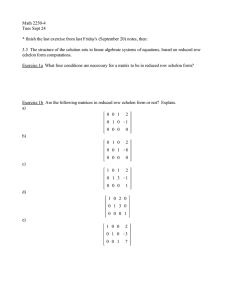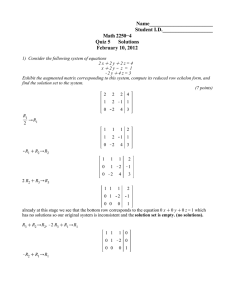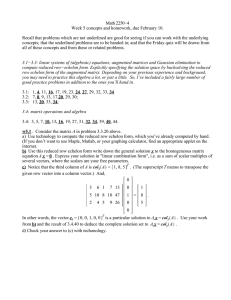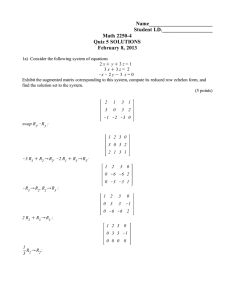Math 2250-010 Mon Feb 3
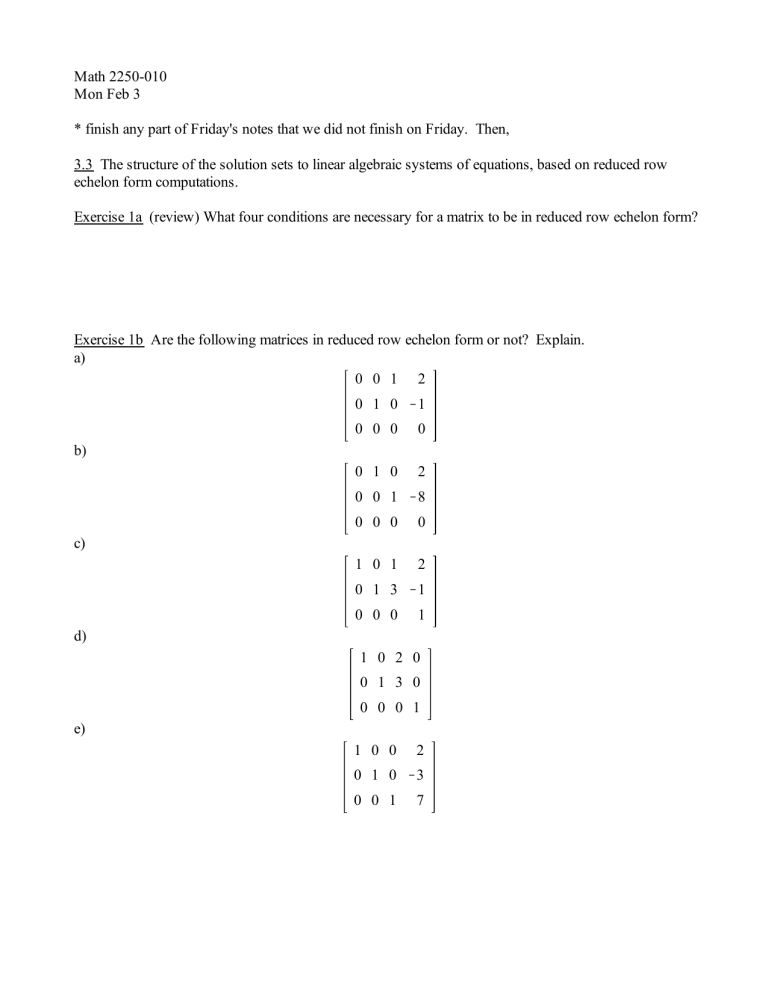
Math 2250-010
Mon Feb 3
* finish any part of Friday's notes that we did not finish on Friday. Then,
3.3 The structure of the solution sets to linear algebraic systems of equations, based on reduced row echelon form computations.
Exercise 1a (review) What four conditions are necessary for a matrix to be in reduced row echelon form?
Exercise 1b Are the following matrices in reduced row echelon form or not? Explain.
a)
0 0 1 2
0 1 0 K 1
0 0 0 0 b)
0 1 0 2
0 0 1 K 8
0 0 0 0 c)
1 0 1 2
0 1 3 K 1
0 0 0 1 d)
1 0 2 0
0 1 3 0
0 0 0 1 e)
1 0 0 2
0 1 0 K 3
0 0 1 7
Exercise 2 Coefficient matrix taken from problem #19, section 3.3, page 174.
> with LinearAlgebra :
A d Matrix 3, 5, 2, 7, K 10, K 19, 13,
1, 3, K 4, K 8, 6,
1, 0, 2, 1, 3 ;
2 7 K 10 K 19 13
A := 1 3 K 4 K 8 6
1 0 2 1 3
ReducedRowEchelonForm A ;
1 0 2 1 3
0 1 K 2 K 3 1
0 0 0 0 0
Let's consider three different linear systems for which A is the coefficient matrix. In the first one, the right hand sides are all zero (what we call the "homogeneous" problem), and I have carefully picked the other two right hand sides. The three right hand sides are separated by the dividing line below:
2 7 K 10 K 19 13 0 7 7
1 3 K 4 K 8 6 0 0 3 .
1 0 2 1 3
We'll try solving three linear systems at once!
b1 d Vector 0, 0, 0 : b2 d Vector 7, 0, 0 : b3 d Vector 7, 3, 0 :
C d A b1 b2 b3 ; # very augmented matrix
ReducedRowEchelonForm C ;
0 0 0
2 7 K 10 K 19 13 0 7 7
C := 1 3 K 4 K 8 6 0 0 3
1 0 2 1 3 0 0 0
1 0 2 1 3 0 0 0
0 1 K 2 K 3 1 0 0 1
0 0 0 0 0 0 1 0
2a) Find the solution sets for each of the three systems, using the reduced row echelon form of C .
Important conceptual questions:
2b) Which of these three solutions could you have written down just from the reduced row echelon form of A, i.e. without using the augmented matrix and the reduced row echelon form of the augmented matrix?
Why?
2c) Linear systems in which right hand side vectors equal zero are called homogeneous linear systems.
Otherwise they are called inhomogeneous or nonhomogeneous. Notice that the general solution to the consistent inhomogeneous system is the sum of a particular solution to it, together with the general solution to the homogeneous system!!! Was this an accident? It's related to an important general concept which will keep coming up in the rest of the course.
Exercise 3) The reduced row echelon form of a (non-augmented) matrix A can tell us a lot about the possible solution sets to linear systems with augmented matrices A b .
First (notation), recall that linear systems a
11 a
21 x
1 x
1
C a
12
C a
22 x
2 x
2
C ... C a
1 n
C ... C a
2 n x n x n
=
=
: : : b b
1
2 a m1 x
1
C a m2 x
2
C ... C a m n x n
= b m can be written more efficiently using the rule we use to multiply a matrix times a vector, b
1 a
11 a
12 a
13
... a
1 n x
1 a
11 x
1 a
21 a
22 a
23
... a
2 n x
2
A x = x
3 d a
21 x
1
: :
: a m1 a m2 a m3
... a m n x n so that they system above can be abbreviated by A x = b .
a m1 x
1
C a
12 x
2
C ...
C a
1 n x n
C a
22 x
2
C ...
C a
2 n x n
:
C a m2 x
2
C ...
C a m n x n
= b
2 b
3
: b n
Then consider the matrix A below, and answer all questions:
A d Matrix 2, 5, 2, 7, K 10, K 19, 13, 1, 3, K 4, K 8, 6 ;
ReducedRowEchelonForm A ;
2 7 K 10 K 19 13
A :=
1 3 K 4 K 8 6
1 0 2 1 3
0 1 K 2 K 3 1
3a) Is the homogeneous problem A x = 0 always solvable?
3b) Is the inhomogeneous problem A x = b solvable no matter the choice of b ?
3c) How many solutions are there? How many free parameters are there in the solution? How does this number relate to the reduced row echelon form of A ?
Exercise 4) Now consider the matrix B and similar questions:
> B d Matrix 3, 2, 1, 2, K 1, 3, 4, 2 ;
ReducedRowEchelonForm B ;
1 2
B := K 1 3
4 2
1 0
0 1
0 0
4a) How many solutions to the homogeneous problem B x = 0 ?
4b) Is the inhomogeneous problem B x = b solvable for every right side vector b ?
4c) When the inhomogeneous problem is solvable, how many solutions does it have?
Exercise 5) Square matrices (i.e number of rows equals number of columns) with 1's down the diagonal which runs from the upper left to lower right corner are special. They are called identity matrices,
I (because I x = x is always true (as long as the vector x is the right size)).
> C d Matrix 4, 4, 1, 0, K 1, 1, 22, K 1, 3, 5, 7, 4, 6, 2, 3, 5, 7, 13 ;
ReducedRowEchelonForm C ;
1 0 K 1 1
C :=
22 K 1 3 5
7 4 6 2
3 5 7 13
1 0 0 0
0 1 0 0
0 0 1 0
0 0 0 1
5a) How many solutions to the homogeneous problem C x = 0 ?
5b) Is the inhomogeneous problem C x = b solvable for every choice of b ?
5c) How many solutions?
Exercise 6: What are your general conclusions?
6a) What conditions on the reduced row echelon form of the matrix A guarantee that the homogeneous equation A x = 0 has infinitely many solutions?
6b) What conditions on the dimensions of A (i.e. number of rows and number of columns) always force infinitely many solutions to the homogeneous problem?
6c) What conditions on the reduced row echelon form of A guarantee that solutions x to A x = b are always unique (if they exist)?
6d) If A is a square matrix ( m=n ), what can you say about the solution set to Ax = b when
∗
The reduced row echelon form of A is the identity matrix?
∗
The reduced row echelon form of A is not the identity matrix?
